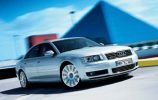Cars
You will find below cars, most often containing a fingerprint sensor. In some cases, I really don't know if the fingerprint reader of the concept car is a real one, sometimes, it is looking very strange ;-)
Non fingerprint-based cars are at the end of the page.
See also some add-on material, mainly for cars
Honda
- (1999) Honda FCX Card ignition key and fingerprint ID system on steering wheel. [Tokyo Motor Show 1999] / Again in 2005 with the FCX concept.
BMW
- (1999) BMW Z22 concept car. The fingerprint sensor is on the door.
Chrysler
- (2000) Chrysler
300 Hemi C concept car. Where is the fingerprint sensor? Close to the ignition key?
A fingerprint scanner hooked up to a tiny camera provides added security, important in any vehicle and especially in a soft top convertible. The vehicle will not function if the driver's fingerprint and picture don't match the system's information.
- (2017 Jan) Chrysler shows the Portal, a concept car with voice and face recognition at the CES.
Cadillac
- (2000) Cadillac Imaj
A special "e-lock" security system opens and locks the vehicle using fingerprint recognition
Volvo
- (2001 Jan) Volvo SCC (Safety Concept Car) with a fingerprint reader in remote control unit (the Volvo Personal Communicator VPC), sensor from Fingerprint Cards


Audi
- (2001 Dec) Audi concept or personalization
Audi Nuvolari / concept car / glovebox

Audi A8
- (Jul 2002) Audi A8: One-touch memory / Siemens VDO, Infineon fingerprint sensor.

- Audi A8 starting with a fingerprint sensor.
- (2007) The Audi S8 still offers the same fingerprint sensor.

Suzuki
Suzuki Concept-S / concept car
- (2002 Sep) Suzuki Concept-S


Suzuki "Sea" Forenza Wagon / concept car
- (2005 Oct) "Sea" Forenza Wagon with the SmartPass Pro biometric technology for locking/unlocking the doors. A fingerprint reader is on the back door: I wonder which sensor it is, a round fingerprint sensor is quite uncommon!
Bertone
- (2002 Mar) Bertone Novanta concept car with an optical fingerprint reader from Green Bit located in the central console.


VolksWagen
- (2005 Oct) EcoRacer concept-car with a fingerprint sensor in the shift gear.
Mitsubishi
- (2006 Jan) Mitsubishi unveils the Concept-CT car.
(The fingerprint sensor should be in the center console?!?).

Citröen
- (2008 Aug) Citröen shows the C6 Palas at the British Motor Show with a fingerprint sensor to access email.
Opel
- (2010 Feb) Opel unveils a concept car, the Flextreme GT/E, with a fingeprint sensor.
Bentley
- (2018 Mar) Bentley offers a biometric secure stowage for the Mulliner and Bentayga.
Hyundai
Mercedes-Benz
- (2020 Jul) Meet the S-Class DIGITAL: "My MBUX" (Mercedes-Benz User Experience).
fingerprint + face + voice. Rien que ça!
Not fingerprint
Iris
A rather unusual application in a car: using the iris as biometric trait.
- Automobile security / United Linker showing Retinasafe-18, which is not a retinal system, but an iris.
Gentex
- (2020 Jan) Gentex. Since 2017, Gentex shows at the CES iris recognition for cars in the rearview interior mirror.
Vein
- (2005 nov) Hitachi demonstrated at the 2005 Tokyo Motor Show a sensor positioned behind the door handle that uses near-infrared light to recognise the pattern of veins across the back of a person's fingers. The handle is designed to guide a driver's hand into the same position each time they open the door, ensuring the finger veins are in the same place for each reading. (Newscientist.com)
- (2007 Oct) Hitachi proposes a finger vein
reader behind the steering wheel.
See also the vein page for more info on vein recognition.